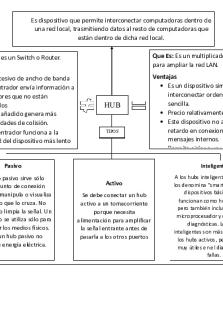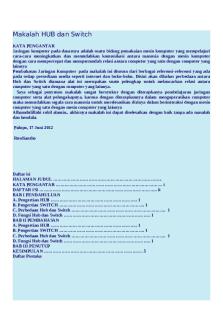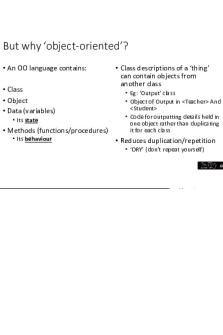Chapter 2 - hub PDF

| Title | Chapter 2 - hub |
|---|---|
| Author | Andrea Moyano |
| Course | biofarmacia y farmacocinética |
| Institution | Universidad de Alcalá |
| Pages | 2 |
| File Size | 161.7 KB |
| File Type | |
| Total Downloads | 94 |
| Total Views | 138 |
Summary
hub...
Description
CHAPTER 2: PHARMACOKINETICS
PHARMACOKINETICS LADME process can be considered by pharmacokinetics as a mathematical tool, but pharmacokinetics is more related into the ADME phases while bio-pharmacy is more related into the release. If we want to obtain data to build different models, we need to obtain samples, by invasive, as collecting blood sample, biopsy needles, in general any method which cannot be physiologically obtained; or non-invasive methods as urine or stool samples and in general the ones which are physiologically obtainable. Pharmacokinetically studies are more based in invasive methods. With the data obtained we should obtain curves that show how drug concentrations change with time. We should analyze this data. The main data obtained are plasma and urinary curves. The profiles obtained depend highly on the administration form, route… (If it’s a bolus IV injection loading the whole volume). This means the first concentrations will be the highest, as there won’t be absorption and if we plot concentration against time it will be something similar to what follows:
If the administration is extravascular, as orally, absorption will occur, as there is a full LADME process. There is a C max in t max where, soon their absorption is considered to finish.
If we are measuring urine and excretion profiles, we have two options. The first will be the cumulative curves, which are those representing the amount of drug excreted in urine, represented in time, and each sample is added to the previous ones. Here is the accumulation of urine against time, obtaining an asymptotic value:
In distributive urine curves, the samples obtained with time are independent from the previous ones. We plot 𝚫U/𝚫t against time and will be similar to those in plasma, in other words it will have the same plot to those depending on if it’s IV pr EV.
KINETICS The rate of transformation of an A product to B will be as V=dB/dt=-dA/dt. In pharmacokinetics A and B can be considered as the drug passing through a biological barrier, just as transfer or also biotransformation. Zero order kinetics represent kinetics in which the rate remains constant, for example a drug injected IV and elimination takes place in a zero-order kinetic, the elimination will take place in a constant decreasing straight line as -dC/dt=k, and if solving gives us C=Co-kt. However, in pharmacokinetics, first order kinetics are the common thing. The plot will usually be curve, in which the differential equation will be: -dC/dt=kC so it depends on the remaining concentration. Thus, the equation will be Ct=Coe-ket. If we put this in logarithm: log Ct=log C0-(K/2,303) *t, which is a slope. Rate is not the same thing as rate constant. In first order kinetics rates will change with time, but not rate constants. In Michaelis Menten kinetics, Km means the substrate concentration at half the concentration rate. The kinetic process works at the maximum rate when concentrations are saturated, we can assume the equation to be V=Vmax. For example, enzymes can be saturated at high concentrations. However if the drug concentration is much lower than the Km value, we can remove the C from the equation, rewriting it as V=(Vmax/Km)*C, and as for a particular drug Vmax and K are going to be constant, in the end it can be V=K*C, following a first order kinetics equation. If working in concentrations near Km, we use the whole equation. In the LADME process L and A usually are zero and we can modulate absorption kinetics with release kinetics if we make this last one slow enough. A, M and E can follow M. Menten kinetics, and overtime the drug interacts with a protein. Finally, any step can follow a first order kinetic, as for example class 3 and 4 drugs need to follow a first order kinetics....
Similar Free PDFs

Chapter 2 - hub
- 2 Pages

Hub - Hub
- 1 Pages

Makalah HUB dan Switch
- 4 Pages

Case Star Hub Answers
- 2 Pages

ZM payment system Hub
- 8 Pages

Grub Hub 10K FY2016 excerpts
- 8 Pages

Manuale HL HUB
- 82 Pages

Managing hub economy
- 21 Pages

PDF Sci-Hub Bean
- 4 Pages

Diferencia entre HUB y Switch
- 2 Pages

Editor HUB Links for You
- 2 Pages

What is Git Hub - Github Basics
- 4 Pages
Popular Institutions
- Tinajero National High School - Annex
- Politeknik Caltex Riau
- Yokohama City University
- SGT University
- University of Al-Qadisiyah
- Divine Word College of Vigan
- Techniek College Rotterdam
- Universidade de Santiago
- Universiti Teknologi MARA Cawangan Johor Kampus Pasir Gudang
- Poltekkes Kemenkes Yogyakarta
- Baguio City National High School
- Colegio san marcos
- preparatoria uno
- Centro de Bachillerato Tecnológico Industrial y de Servicios No. 107
- Dalian Maritime University
- Quang Trung Secondary School
- Colegio Tecnológico en Informática
- Corporación Regional de Educación Superior
- Grupo CEDVA
- Dar Al Uloom University
- Centro de Estudios Preuniversitarios de la Universidad Nacional de Ingeniería
- 上智大学
- Aakash International School, Nuna Majara
- San Felipe Neri Catholic School
- Kang Chiao International School - New Taipei City
- Misamis Occidental National High School
- Institución Educativa Escuela Normal Juan Ladrilleros
- Kolehiyo ng Pantukan
- Batanes State College
- Instituto Continental
- Sekolah Menengah Kejuruan Kesehatan Kaltara (Tarakan)
- Colegio de La Inmaculada Concepcion - Cebu



